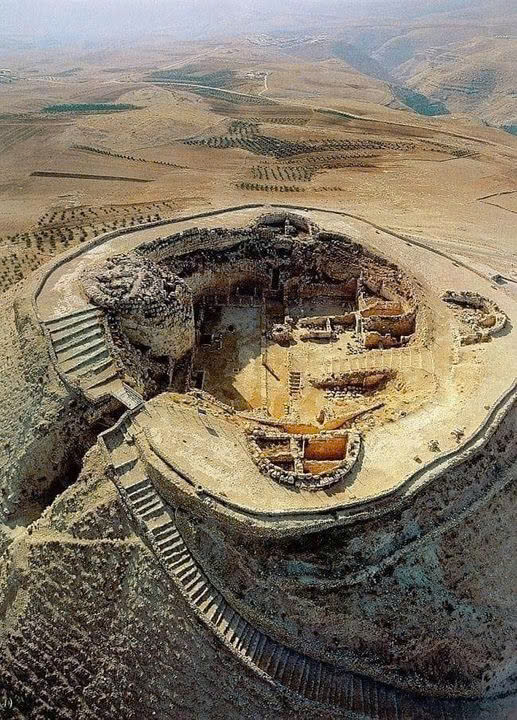Nestled in the heart of the Judean Desert near Bethlehem, Israel, lies Herodium, an extraordinary architectural marvel commissioned by King Herod the Great. This impressive fortress-palace complex, constructed between 23 and 15 BCE, served a dual role as both a lavish royal residence and the final resting place of the king. Herodium stands as a testament to King Herod’s ambition, vision, and his desire to leave an indelible mark on history. Today, this iconic site is celebrated for its remarkable design, historical significance, and its unique ability to transport visitors back to the grandeur of the Herodian period.
As visitors approach Herodium, they are immediately struck by its imposing presence. The complex is built on an artificially shaped hill that rises conspicuously above the surrounding desert landscape. The decision to construct Herodium on this elevated site was no mere coincidence; it reflects Herod’s strategic brilliance. From its commanding position, the fortress offered panoramic views of the Judean Desert and nearby settlements, serving as both a defensive stronghold and a symbol of power. This elevated vantage point also highlights Herod’s attention to detail, ensuring that Herodium would stand out as a symbol of his dominance and influence.

The architectural splendor of Herodium becomes evident as one delves deeper into its ruins. The site boasts luxurious living quarters that were designed to provide unparalleled comfort and sophistication. These spaces were adorned with intricate frescoes, elegant mosaics, and finely crafted furnishings, reflecting the opulence characteristic of Herod’s reign. Among the most remarkable features of Herodium are the sophisticated bathhouses, which showcase the ingenuity of ancient engineering. These bathhouses included heated pools, steam rooms, and elaborate water systems, underscoring Herod’s commitment to luxury and innovation. The attention to detail in these spaces reveals the king’s desire to create an environment that catered to his royal court’s every need while also serving as a statement of his architectural prowess.
The crowning jewel of Herodium is undoubtedly the circular tomb, which was meticulously designed by King Herod himself. This tomb, intended to serve as his eternal resting place, exemplifies the grandeur and meticulous planning that defined Herod’s architectural projects. The tomb’s design reflects a blend of Roman and local influences, showcasing Herod’s ability to merge cultural elements to create something truly unique. The sheer scale and precision of the tomb underscore Herod’s determination to immortalize his legacy through architecture. For modern archaeologists and historians, the tomb offers invaluable insights into the burial practices and artistic sensibilities of the time.
Beyond its aesthetic and residential features, Herodium also served as a model of strategic design and defensive excellence. The complex was fortified with robust walls, watchtowers, and concealed passages, making it an impenetrable fortress in times of conflict. These defensive features, seamlessly integrated with the site’s luxurious elements, highlight Herod’s ability to combine practicality with grandeur. The fortress was not merely a refuge during times of unrest but also a symbol of Herod’s ingenuity in creating multi-functional structures that could serve both defensive and ceremonial purposes.
Herodium’s significance extends far beyond its historical and architectural value. In modern times, it has become an essential archaeological site, offering a wealth of information about the Herodian period and the broader context of ancient Judean society. Excavations at Herodium have unearthed a treasure trove of artifacts, including pottery, coins, and architectural fragments, which provide valuable insights into the daily lives, cultural practices, and technological advancements of the time. These findings have contributed to a deeper understanding of Herod’s reign and its enduring impact on the region.
Visiting Herodium today is akin to embarking on a journey through time. The site’s well-preserved ruins offer a tangible connection to the past, allowing visitors to experience firsthand the magnificence of King Herod’s vision. Walking through the remains of the palace, exploring the bathhouses, and gazing upon the monumental tomb, one cannot help but marvel at the ingenuity and ambition that brought Herodium to life. The experience is both humbling and awe-inspiring, serving as a reminder of the enduring legacy of ancient civilizations.
Herodium’s story is also one of resilience and rediscovery. Over the centuries, the site faced periods of neglect, natural erosion, and looting, which threatened to obscure its historical significance. However, thanks to the efforts of archaeologists and preservationists, Herodium has been restored to its rightful place as a cultural and historical treasure. The ongoing work at the site ensures that future generations can continue to learn from and appreciate this remarkable testament to human creativity and determination.
One of the most striking aspects of Herodium is its ability to bridge the past and present. While it stands as a relic of a bygone era, the lessons and insights it offers remain relevant today. Herodium reminds us of the power of vision, the importance of cultural preservation, and the enduring impact of architecture as a means of storytelling. For historians, architects, and visitors alike, Herodium serves as a source of inspiration and a testament to the enduring legacy of King Herod.
In conclusion, Herodium is far more than an archaeological site; it is a window into the past and a celebration of human ingenuity. From its luxurious living quarters and sophisticated bathhouses to its strategic design and monumental tomb, Herodium encapsulates the essence of the Herodian period and the grandeur of King Herod’s reign. As visitors explore its ruins and uncover its secrets, they are reminded of the remarkable achievements of ancient civilizations and the enduring power of architecture to connect us with history. Herodium stands not only as a tribute to King Herod’s legacy but also as a symbol of the timeless beauty and significance of cultural heritage.





